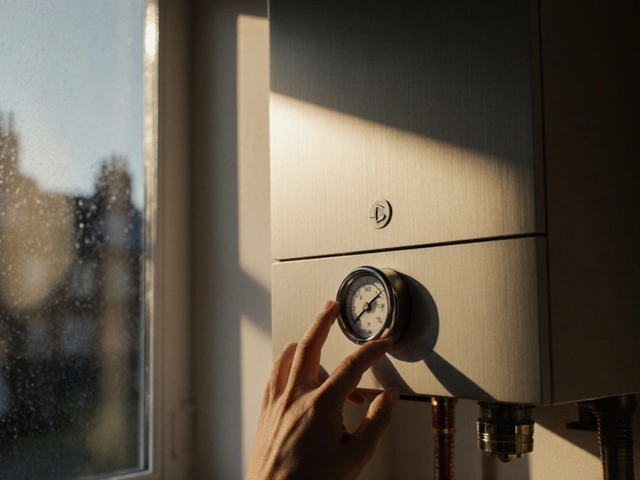Got an oven that won’t heat up? You’re not alone. A lot of homeowners face a cold oven at some point, and most of the time the fix is easier than you think. In this guide we’ll walk through the common reasons an oven stops heating, show you how to replace a faulty element, and tell you when it’s smarter to call a professional.
The first thing to check is power. Make sure the oven is plugged in and the circuit breaker hasn’t tripped. If the display lights up but the oven stays cold, the heating element is the usual suspect. Other culprits include a broken thermostat, a bad igniter (for gas ovens), or a loose connection inside the control panel.
One quick test is the continuity check. With the oven unplugged, pull out the element and use a multimeter. If the meter shows no continuity, the element is dead and needs replacing. This test takes just a few minutes and saves you a pricey service call.
Before you start, gather a few tools: a screwdriver set, a nut driver, and a multimeter. Safety first—always disconnect the oven from the power source. Most electric ovens have two screws holding the element in place; remove them, slide the element out, and disconnect the wiring harness.
Match the new element to the old one by checking the part number printed on the metal. Snap the new element into the wiring connector, slide it back into its slot, and tighten the screws. Reconnect the power and run a quick test cycle. If the oven heats up, you’ve saved yourself time and money.
While you’re inside, glance at the surrounding wiring. Look for signs of wear, burnt spots, or loose connections. Tightening a loose wire can sometimes solve intermittent heating issues without needing a new part.
If you’re dealing with a gas oven, the problem might be the igniter. A faulty igniter will glow but won’t spark, leaving the oven cold. Replacing an igniter follows a similar process: remove the old piece, note how the wires attach, and install the new one. Always follow the manufacturer’s instructions for gas safety.
When a DIY fix feels beyond your comfort zone—like a broken control board or a persistent gas leak—it’s time to call in a pro. An experienced appliance technician can safely test high-voltage components and ensure everything complies with local codes.
Choosing the right professional matters. Look for a local repair service that specializes in ovens and is Gas Safe registered for gas work. A reputable company will give you a clear quote before starting and explain whether a repair or replacement makes more sense.
Repair vs. replace is a common dilemma. If your oven is more than 10 years old, the cost of a new heating element plus labor might approach the price of a new oven. In that case, ask the technician to compare energy efficiency ratings—newer models often use less electricity, saving you money in the long run.
Regular maintenance can prevent many oven problems. Keep the interior clean, wipe away spills before they harden, and check the door seal for gaps. A tight seal helps retain heat, reducing wear on the heating element.
In summary, most oven heating issues boil down to a bad element, a tripped breaker, or a faulty thermostat. With a few basic tools you can replace an element yourself and get back to baking in no time. When the fix looks complicated, don’t hesitate to reach out to a qualified repair service. A well‑maintained oven will last for years, saving you both hassle and expense.

If your electric oven suddenly stops working, don't panic. This article explores common issues with electric ovens and provides practical tips for troubleshooting and repair. From understanding how different components work to knowing when it's time to call a professional, you'll find the go-to advice you need to get your oven back in working order. Avoid the hassle of guesswork and get straightforward guidance on keeping your kitchen running smoothly. Practical insights on oven maintenance await you.

Find out how much boiler repair costs in 2025, what factors affect the price, typical price ranges, and tips to get fair quotes and save money.

Resetting a freezer compressor may sound daunting, but it's an essential skill for maintaining your appliance's efficiency. Compressors can occasionally need a reset to function properly, potentially saving you from costly repairs or replacements. This article walks you through the steps to safely reset your freezer compressor and offers tips to prevent future issues. Understanding when and why to reset your compressor can keep your freezer running smoothly and extend its lifespan.

A 40-year-old boiler can pose potential safety risks. Understanding the wear and tear it undergoes over the decades is crucial. Regular maintenance and safety checks are essential to ensure it operates safely. Homeowners should consider the pros and cons of keeping such an old appliance. Discover tips and advice on making informed decisions regarding your boiler's safety and efficiency.

Fixing an extractor fan can be a straightforward process if approached with the right tools and knowledge. This article delves into various factors affecting repair time, common issues encountered, necessary tools, and preventive tips to maintain optimal performance. Readers will discover useful advice on diagnosing problems and learn how to efficiently address and resolve them, ensuring a smooth and fresh airflow in kitchens and bathrooms.

Step‑by‑step guide to diagnose common boiler problems, covering pressure, thermostat, fault codes, leaks, and when to call a professional.